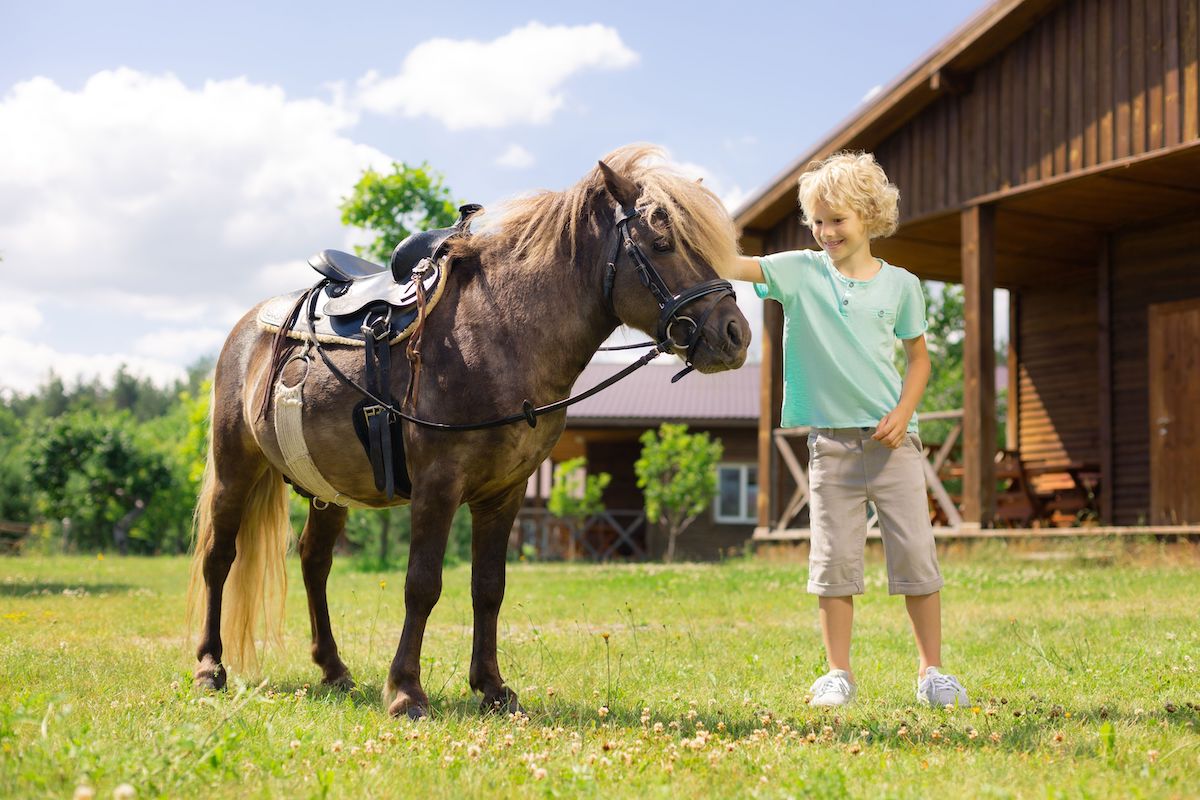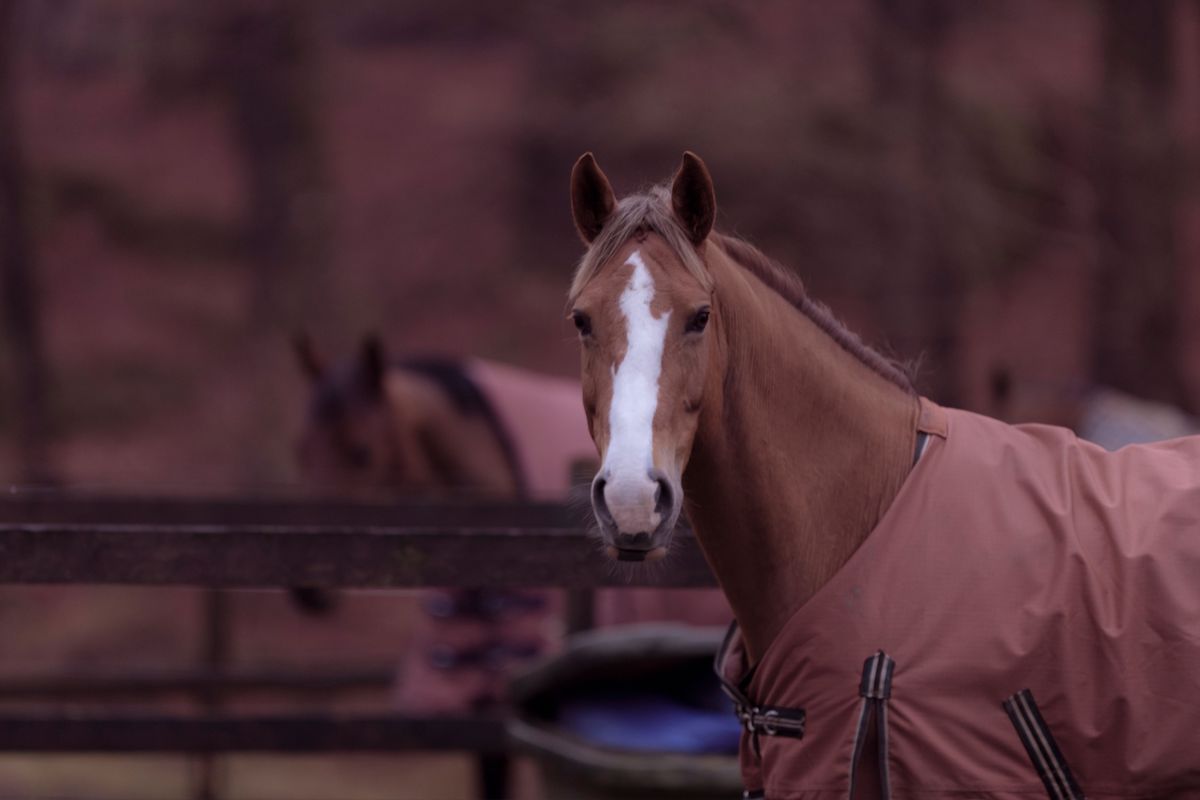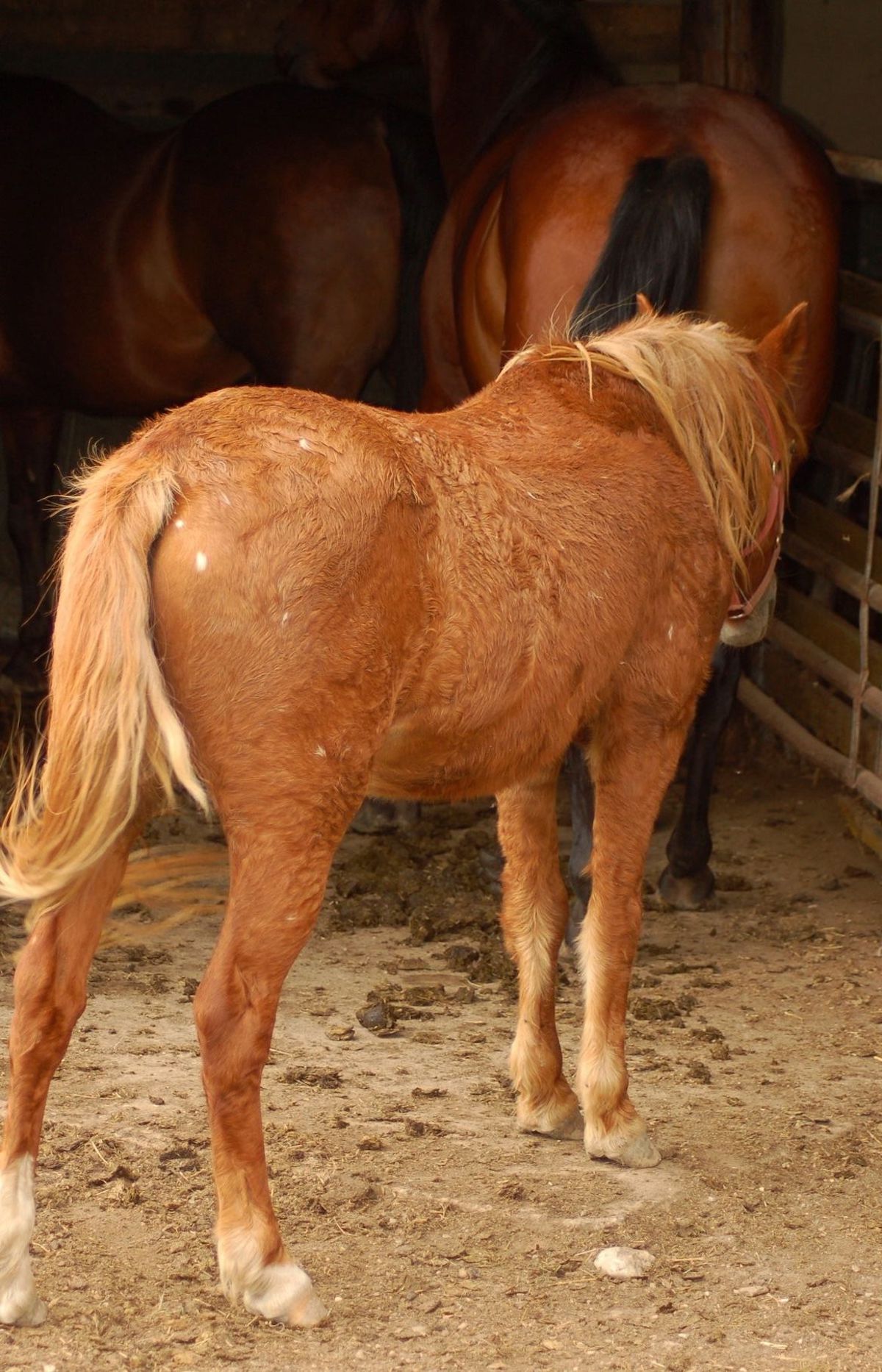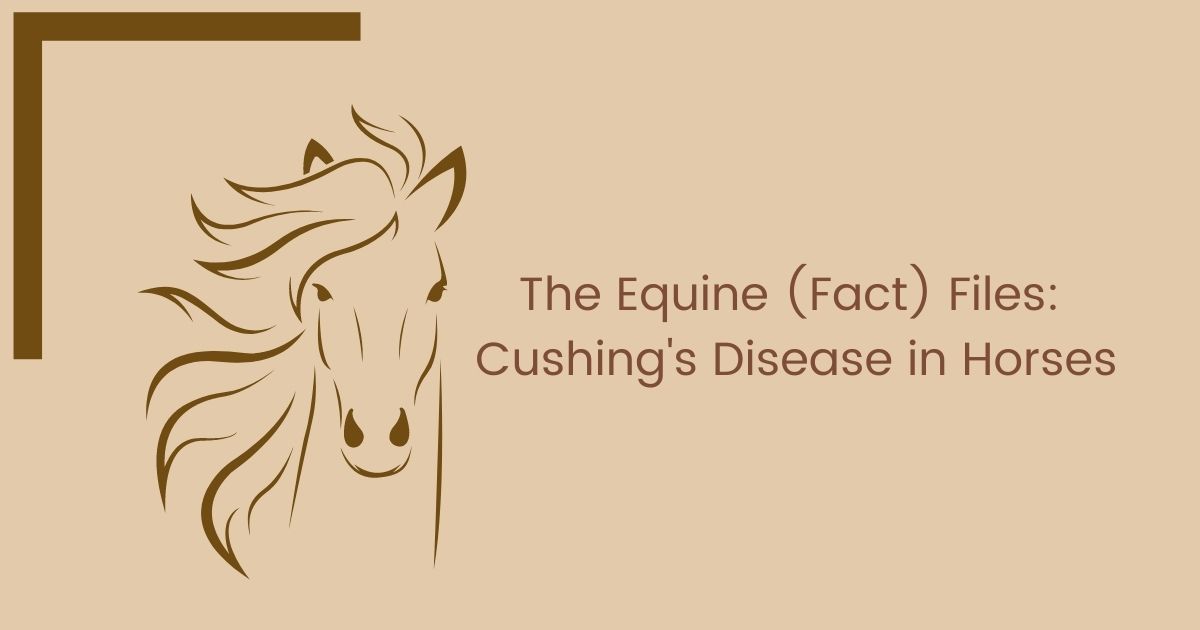What is Cushing’s Disease
Cushing’s disease in horses is very common. It usually forms in the pituitary gland located below the brain. The gland produces excess levels of hormone adrenocorticotropin (ACTH) after getting signals from the brain. So, what happens is that mechanisms that control hormone production in the pituitary gland are damaged.
The adrenal gland leads to the increase of cortisol, causing hormonal imbalances. The results are loss of muscle mass, susceptibility to infections, and a long shaggy hair coat. Cushing’s disease mainly affects equines that are over ten years old.
Most of the time, vets will diagnose the disease at the age of 19. In PPID in horses, the most affected are ponies. On the other hand, geldings and mares are also likely to be affected.
Read on to find out more information about Cushing’s disease in equines.

Cushing’s Disease Symptoms and Clinical Signs in Horses (Early Vs. Advanced)
There are several signs and symptoms associated with Cushing’s disease. You need to be aware of them so that your horse gets treatment in time. Below are early and advanced symptoms.
Early symptoms
- Change in behavior– you will notice changes in your horse’s personality. This is one of the earliest symptoms of PPID in horses.
- Delayed shedding and hair coat abnormalities– one glance at your horse, and you will notice a delay in winter coat shedding in some areas. Also, the summer coat may appear different in the same places.
- Loss of Topline– in this case, you will see sunken shoulders, prominent withers, dished appearance around the hip bones, and a prominent spine.
- Regional adiposity– here, you will notice fat deposits along with the tail head, above the eyes, and along the crested neck.
- Laminitis– this is whereby there is inflammation in the layers of tissue in the hoof.
- Infertility– you will start noticing that reproduction cycles are abnormal or not there at all.
- Decreased athletic performance– your horse will tend to be inactive compared to a normal one.
Advanced symptoms
- Blindness-this is an advanced sign that your horse is not okay. You will also notice other nerve disorders.
- Change in behavior-the changes that happen during the early stages will be more common in the advanced stage.
- Laminitis-this is a sign that occurs both in the early and advanced stages.
- Delayed or absent shedding– at this stage, you will notice the changes in how the horses’ coat appears. There will also be other hair coat abnormalities.
- Skeletal muscle atrophy- You will notice that the muscles along the horse’s back (epaxial) start disappearing.
- Rounded abdomen– the horse’s belly may look bloated and enlarged.
- Abnormal sweating– your horse may sweat more or less. This happens mainly on the neck and shoulders.
- Excessive urination and thirst– the horse will always be thirsty and urinate excessively.
- Recurrent infections– PPID horses have infections that keep recurring. They include sinusitis, hoof abscesses, skin infections, and conjunctivitis.
For you to identify Laminitis, look out for the following:
- A stiff posture.
- Hooves that feel warm.
- Hoof abnormalities like hoof growth rings.
- A white line between the sole and the hoof wall.
- Refusal to pick up the feet or move.
- A position where a horse appears to rock to and fro.
- Shifting weight from hoof to hoof.
When you notice the above symptoms, kindly seek the help of an equine veterinary professional.
Causes of Equine Cushing’s Disease
Usually, the hypothalamus that is at the base of the brain regulates activities in the pituitary gland. This includes the production of hormones that are needed in a horse’s body. However, equine Cushing’s disease happens when there is excessive release of hormones.
As a result, you will notice the early stages of symptoms and the advanced ones in your horse. The most noticeable sign is hypertrichosis which is a curly or long hair coat that does not shed.

How is Cushing’s Disease in Horses Diagnosed?
What you need to observe are the early signs of Cushing in horses. The early signs will enable you to seek treatment early enough before the progression of the disease. We have mentioned some of the early symptoms you need to know. Look out for decreased performance or weight loss. The shaggy hair coat is an indication that the PPID has advanced.
So, don’t wait to see the shaggy coat. Early treatment is good as there will be greater chances of your horse positively responding to medication.
Once you visit a vet, you will provide the horse’s history. Let the vet know the previous health of the horse compared to the recent changes. The history will include you talking about medications administered before, diet, daily habits, attitude, exercise, appearance, among other things. Ensure you have all the medical records amongst other documents on hand.
After the history, the vet will conduct a physical examination. They will observe the horse while touching it to get the differences from the previous records. These may include:
- Tenderness of hoof testers on the feet’s soles.
- Starting of fat deposits.
- Mild pain to palpation of ligaments and tendons in the legs.
- Observing the topline for muscle loss.
After that, the vet could recommend a blood test based on the symptoms. Blood tests are good since they will always rule in or out whether there is Cushing’s disease. Some factors will always determine whether the vet will do a blood test or not. It could be the stages of the disease or the time of the year.
Also, the Equine Endocrinology Group (EEG updates recommendations for tests regularly. This is according to the latest research. In addition, they publish flow charts that vets use for diagnostic purposes.
Treating Equine Cushing’s Disease
Based on the EEG’s flow chart, horses with signs of PPID or a history of PPID are given Pergolide for horses. Pergolide does not cure Cushing’s horses but improves the quality of life. It prevents the disease from progressing and gets rid of some symptoms. To avoid risks like Laminitis, recurring infections, amongst others, start treatment at an early stage.
After administering the Pergolide, you can expect to see improvements after one month. However, it may even take two to three months. A veterinarian will be monitoring the progress and advise when to take more blood tests or not.
In case of any side effects, let your vet know. Lack of appetite is the most common side effect of pergolide. The vet will know what to do to get the horse back to eat again as normal.
The Living, Management and Preventative Care of PPID In Horses
To manage equine Cushing’s disease, you need to seek medication. If you work closely with an equine veterinarian in all areas of a horse’s life, then your horse will be in good hands. The vet should know about the horse’s feeding program and also how it exercises. This is important, especially if your horse has insulin dysregulation or Laminitis.
Preventive Care
If a vet professional has diagnosed your horse with PPID, you should give it special attention in areas like wellness. Horses suffering from Cushing’s require a lot of additional maintenance. For instance, controlling parasites, vaccinations, dental care, and hoof care in senior horses.
Senior horses are prone to infections, parasitism, tooth and gum disease. The infections may get worse when the horse has PPID.
Horse owners also need to observe a horse with Cushing’s and get ready to increase care in different seasons. For instance, in summer, horses with shaggy hair coats that are long need clipping to remove unshed winter hair. On the other hand, moving air helps with cooling. So, you can provide fans to your horses even though they also cool themselves naturally.
Sweating helps horses to cool themselves. So, supplement the horse with salts and electrolytes that may get lost during sweating.
During the cold weather, provide your Cushing’s horse with blankets or warm bedding. Also, provide more calories in the form of hay. The calories are a good source of energy that produces the warmth necessary in cold and windy weather.
Equines with Cushing’s may experience behavioral changes. For instance, they may not be active in a herd and hence not access water and food. Therefore, you will need to adjust your horse’s life accordingly.

Why was the Name Changed from Cushing’s Disease to PPID?
Previously, equine Cushing’s was a name similar to pituitary conditions in dogs and people. Both are called Cushing’s syndrome. Today, experts call the Cushing’s syndrome in horses “pituitary pars intermedia dysfunction” (PPID).
In equines, the intermediate lobe of the pituitary gland is affected. This is unlike in humans and dogs where the anterior lobe faults.
Recommended Dietary and Supplemental Support of PPID in Equines
Horses suffering from Cushing’s diet vary. Some horses may have PPID with insulin abnormality while others without insulin abnormality. Both have different diets:
Horses with PPID Only
Some horses test positive for PPID but no abnormality in insulin (EMS). You can expect much change in such a case if the diet is high in forage. All these will depend on the weight, health condition, and age of the horse.
Seek counsel from a vet in cases where a Cushing’s horse is overweight or underweight. A well-versed nutritionist will be of great help to identify the best diet.
Horses with PPID and EMS
Some horses test positive for Cushing’s disease and, at the same time, have irregular insulin levels. It could be insulin resistance(IR) or hyperinsulinemia (Hi). In this case, the diet needs to be adjusted. For overweight horses that suffer from Cushing’s and EMS, the Equine Endocrinology Group (EEG) advises the following to reduce fat:
- Reduce the number of calories. Alternatively, give a multi-vitamin instead of grains.
- Feed the animals with hay that is 12% NSC or non-structural carbohydrates like starches and sugars.
- Don’t allow the horse to feed on any grass.
- Find out whether you can give low NSC treats during the weight-loss period.
After finding out that the blood work is improving with no signs of Laminitis and the bloodwork improves, a little pasture and an NSC treat may be acceptable. To limit grazing, use a muzzle, set a track system, or strip grazing.
Administering oral medicine to horses with Cushing’s can be very difficult. To make it an easy task, find a treat that the horse likes. Then, hide the pills in the treat, and the horse will swallow without knowing.
When it comes to supplements, follow the guidance of a vet. For example, give electrolytes to PPID horses that sweat a lot. Give multi-vitamin instead of fortified grain. To rebuild topline muscles, provide amino acids (protein).
Use vitamin E and omega-3 fatty acids to bridge the gap between dried forage and fresh grass. Other essential supplements are antioxidants that help to combat oxidative stress.

My Horse Has Cushing’s Disease. Can I Ride Him?
The answer is Yes, you can. However, it depends on various factors. EEG recommends exercises for horses with PPID and EMS. As long as the feet are stable, you can ride your horse.
There are specific guidelines that the EEG issues concerning the intensity of exercise. However, Most experts believe that walk, canter, and trot (ridden and unridden) help reduce weight. They also help to improve the sensitivity of insulin in horses that have IR and HI.
So, once you notice changes in your horse, visit a vet for the proper diagnosis. Pergolide may not be the exact cure, but it will help prolong the life of your horse. Also, appropriate nutrition and exercise may help improve the quality of life of a horse suffering from Cushing’s.
